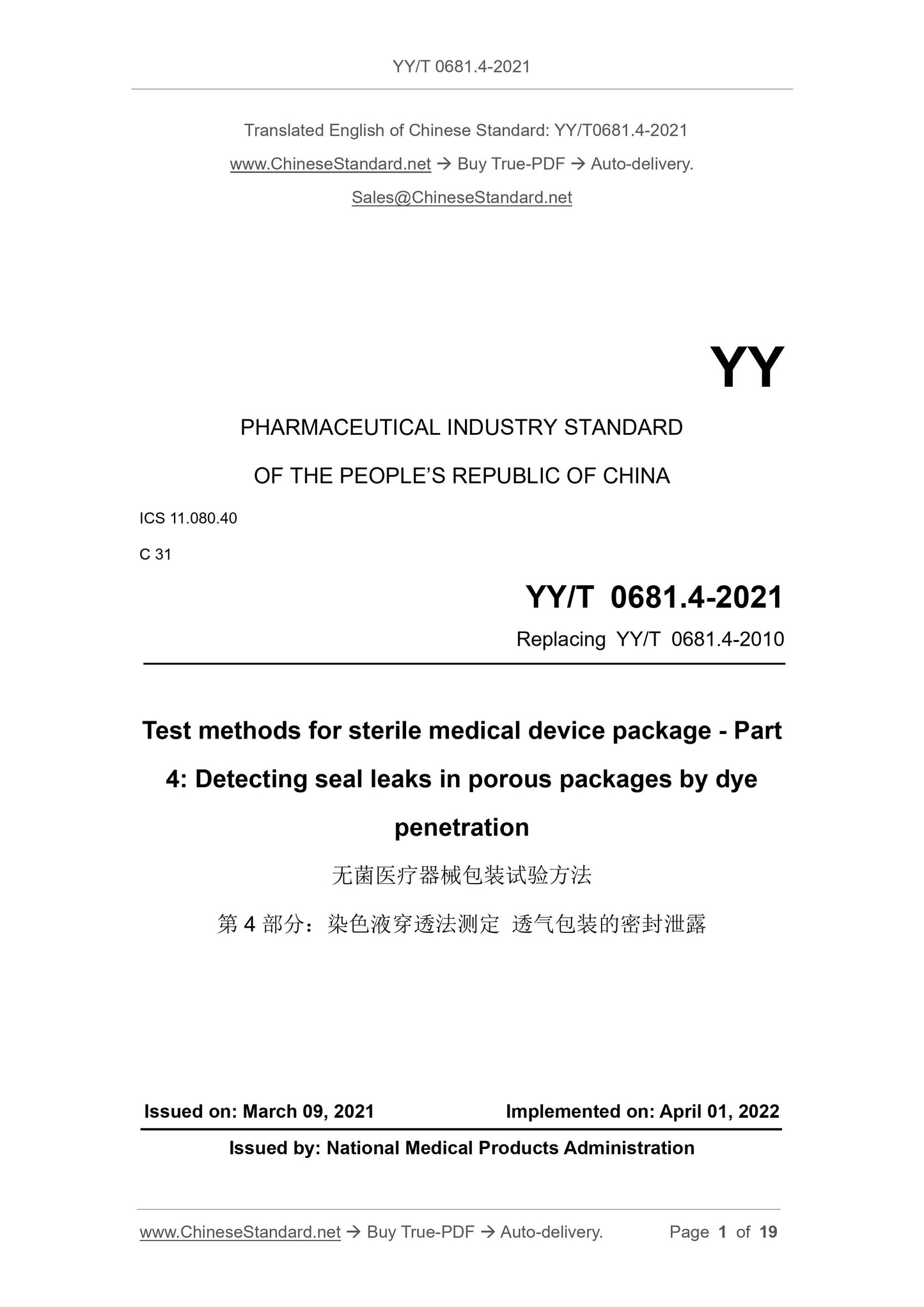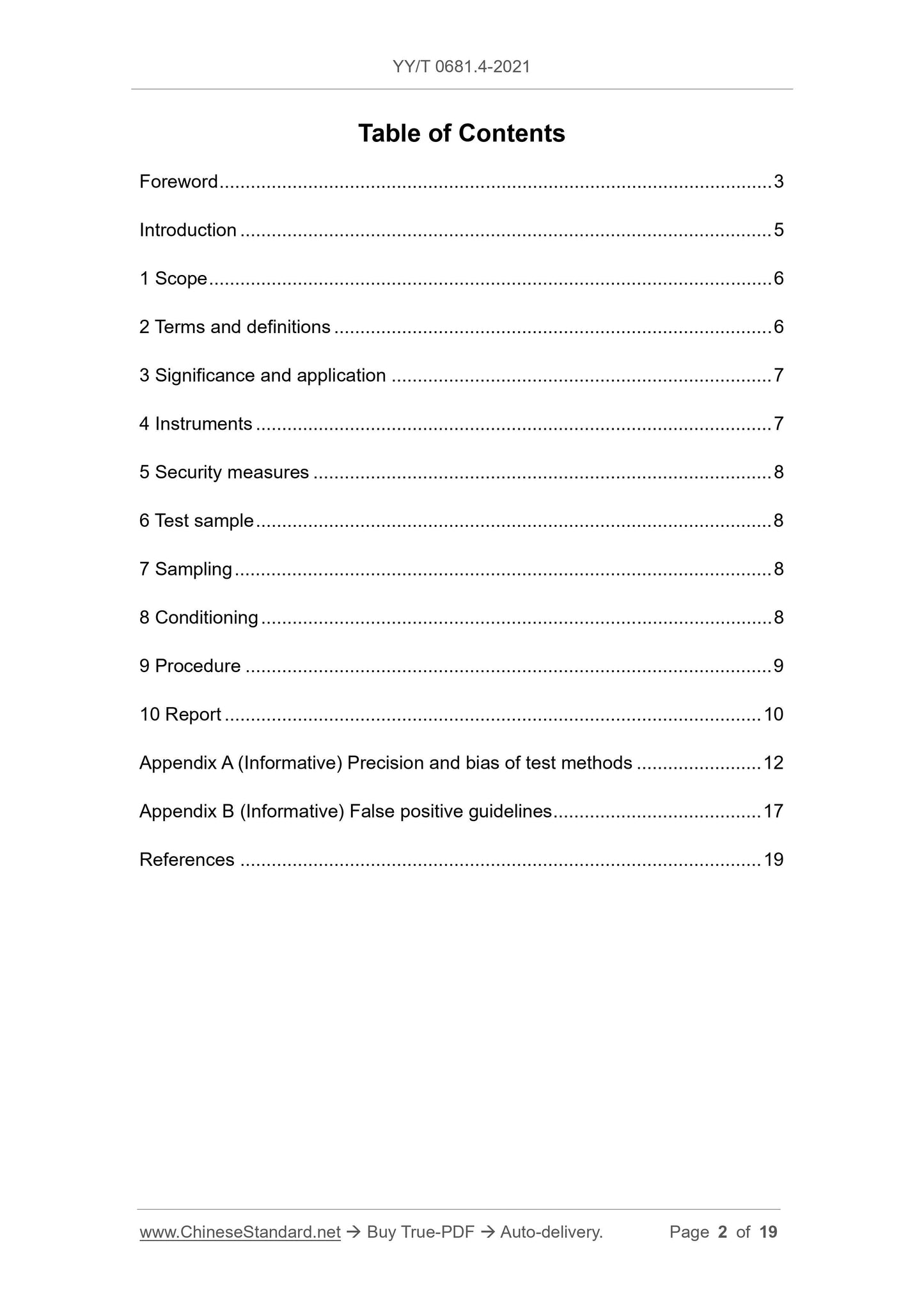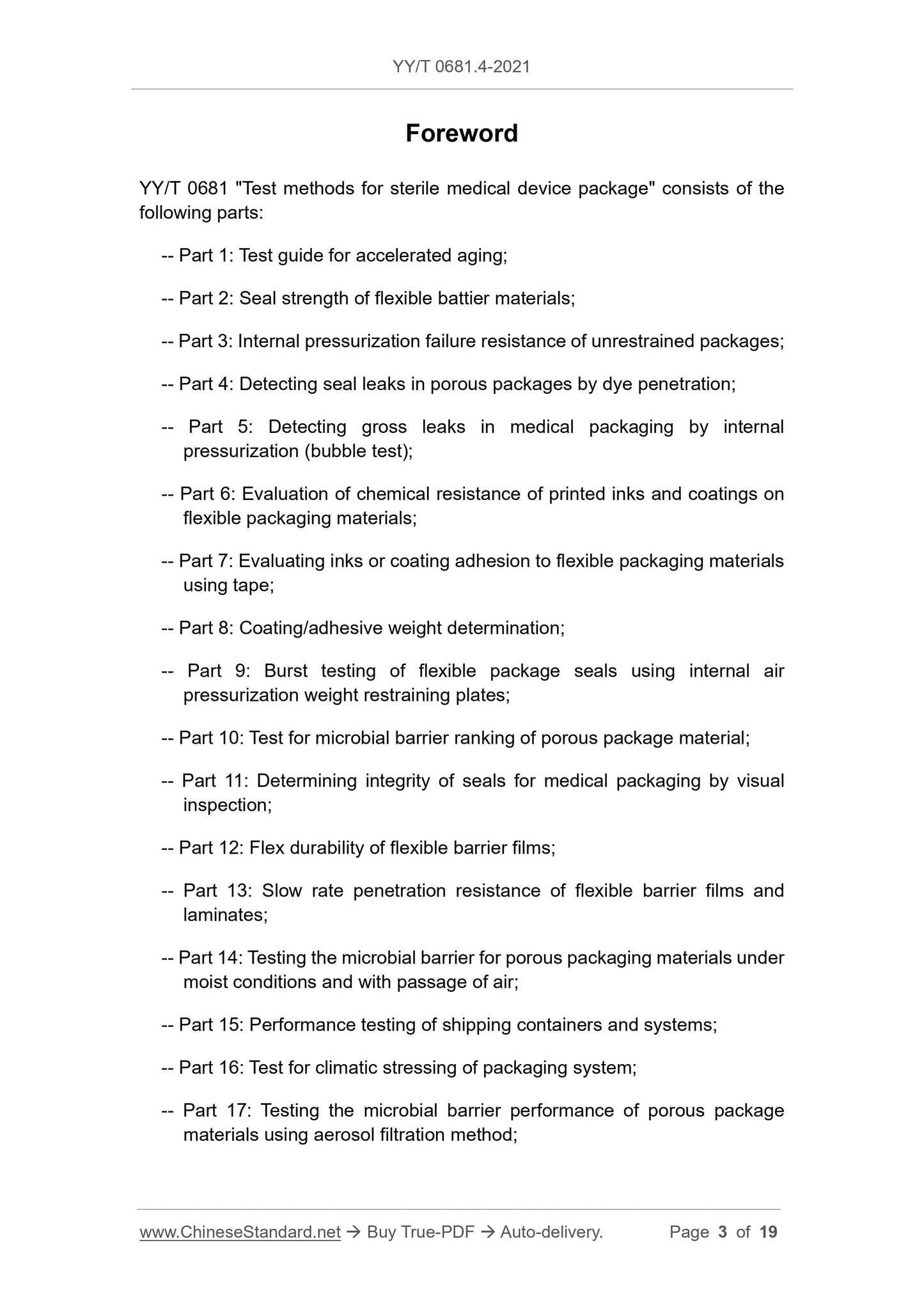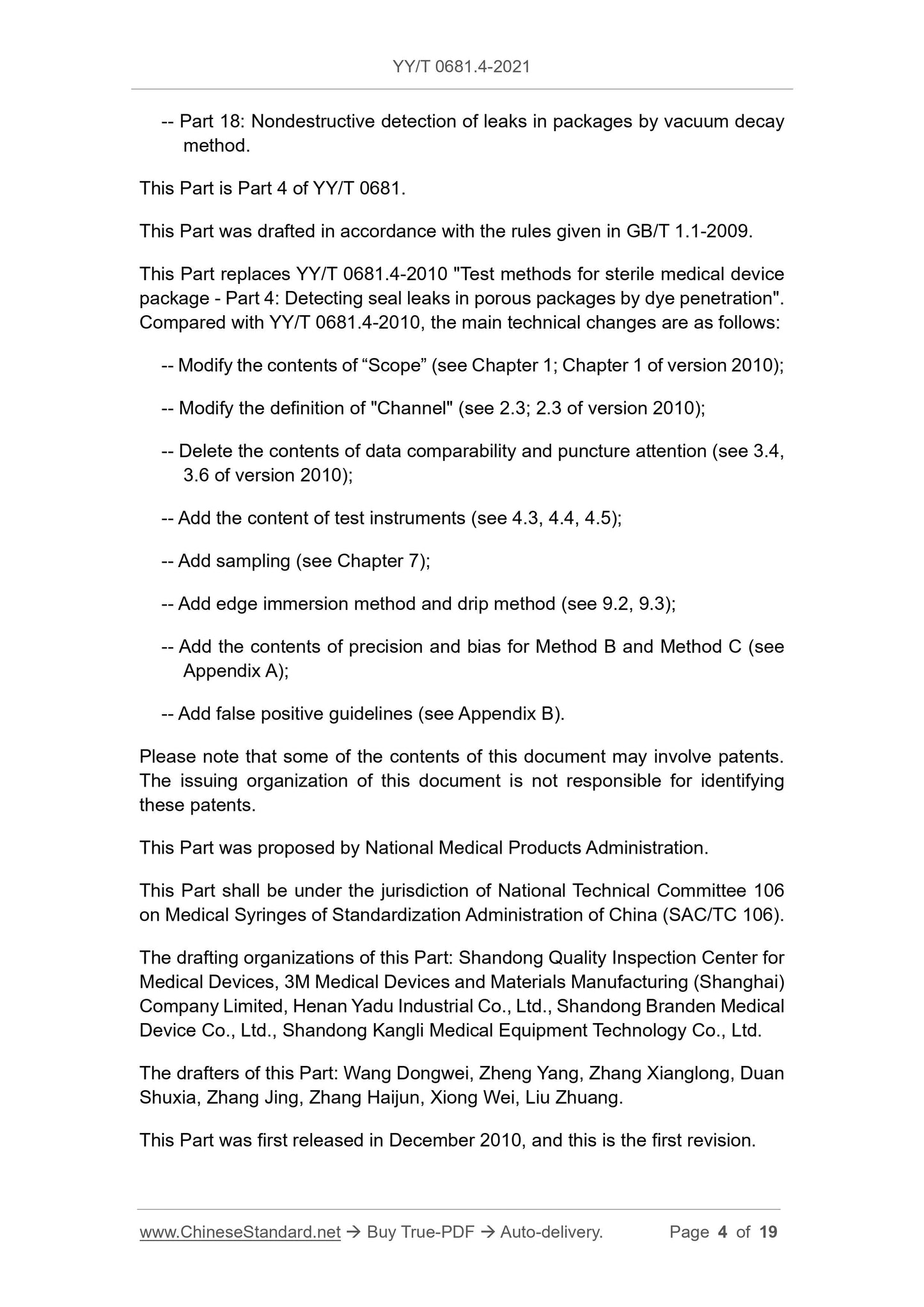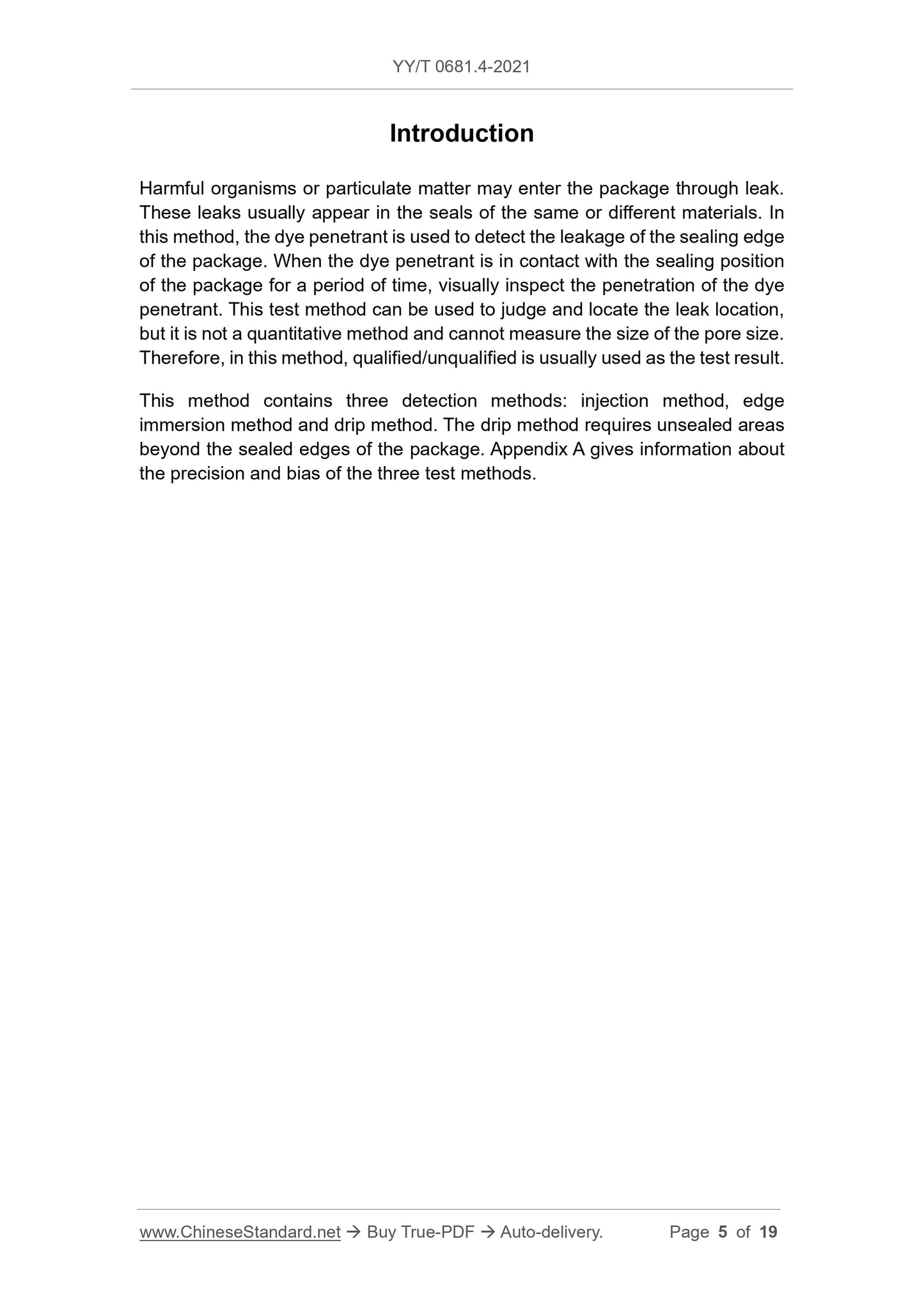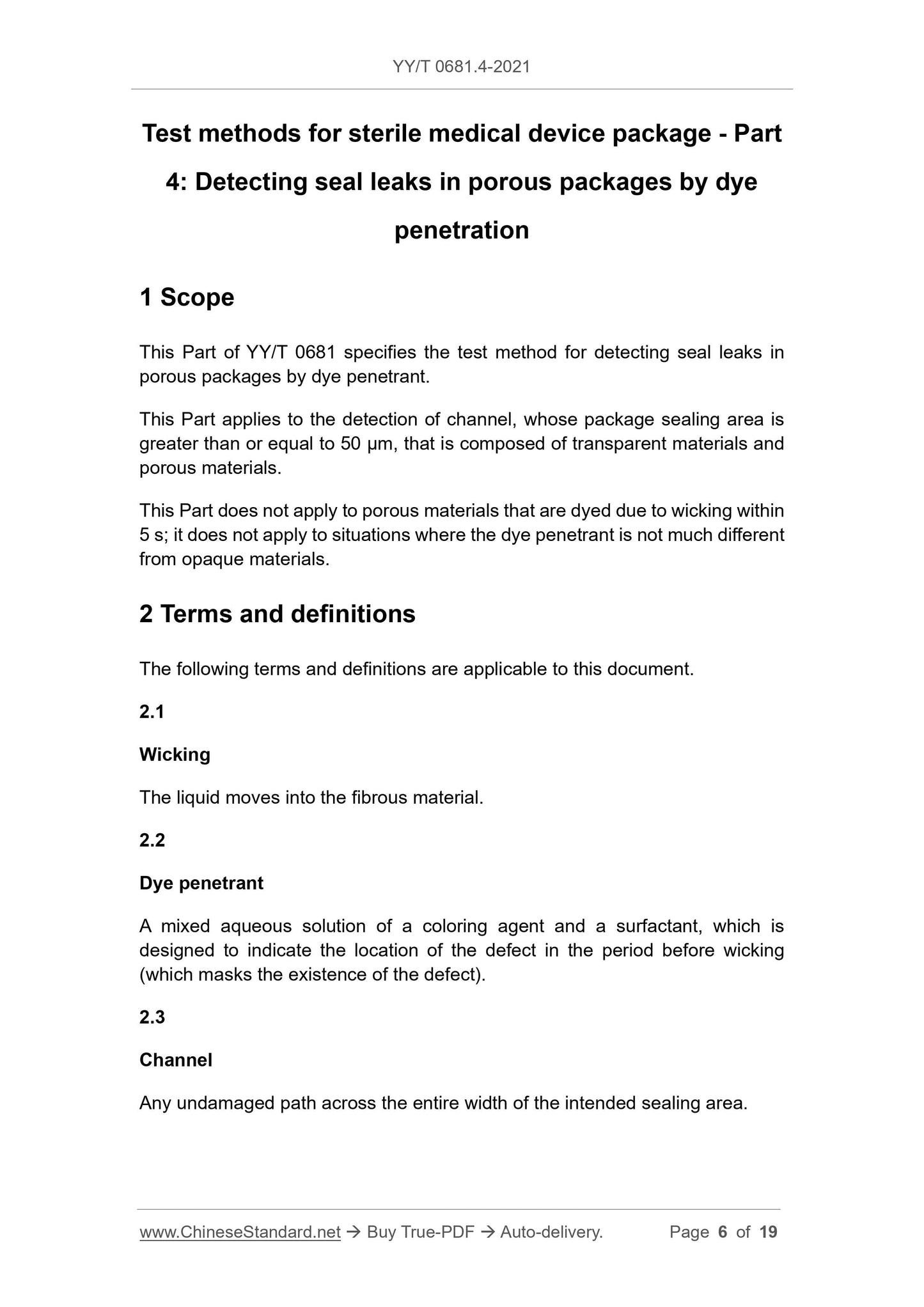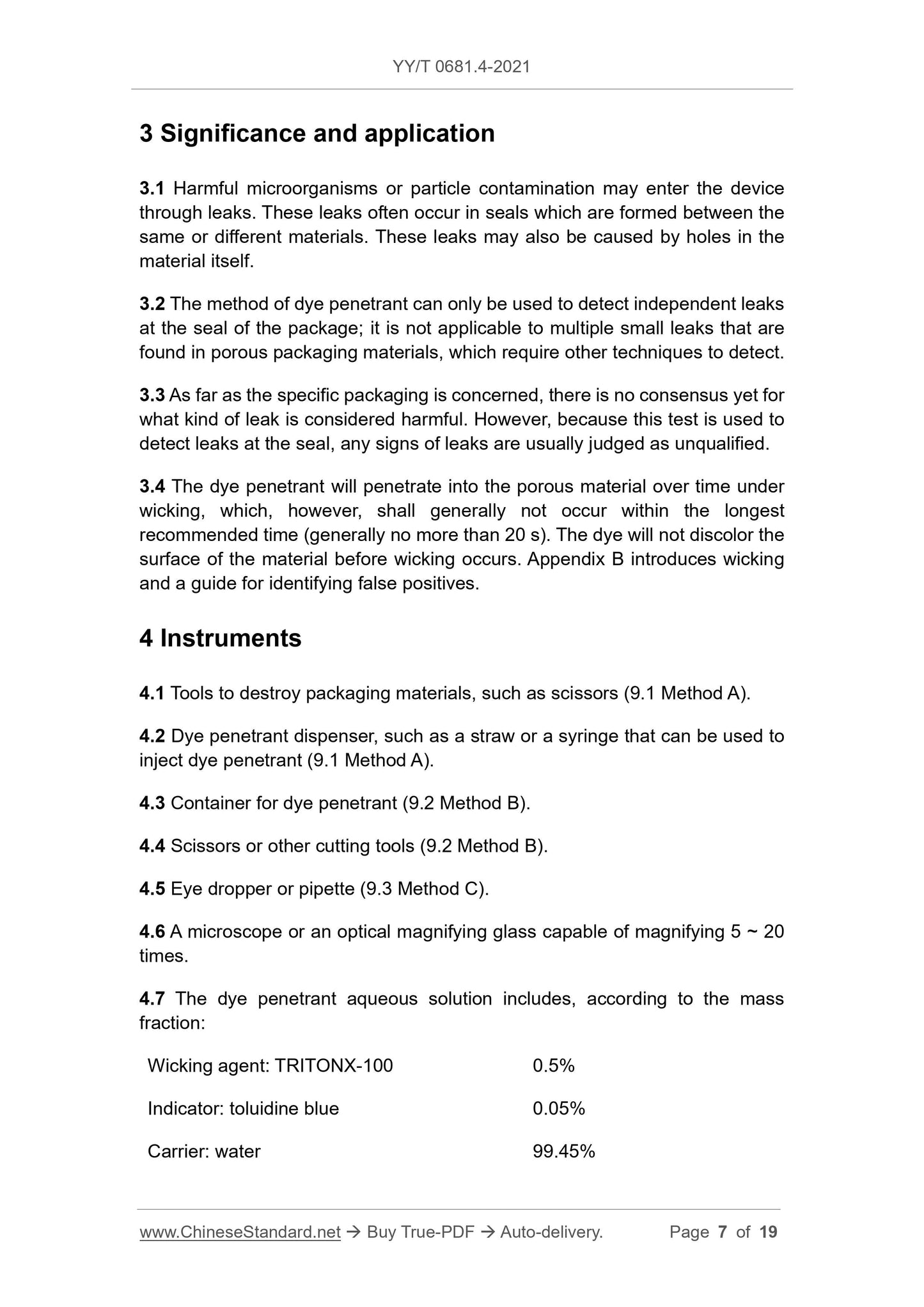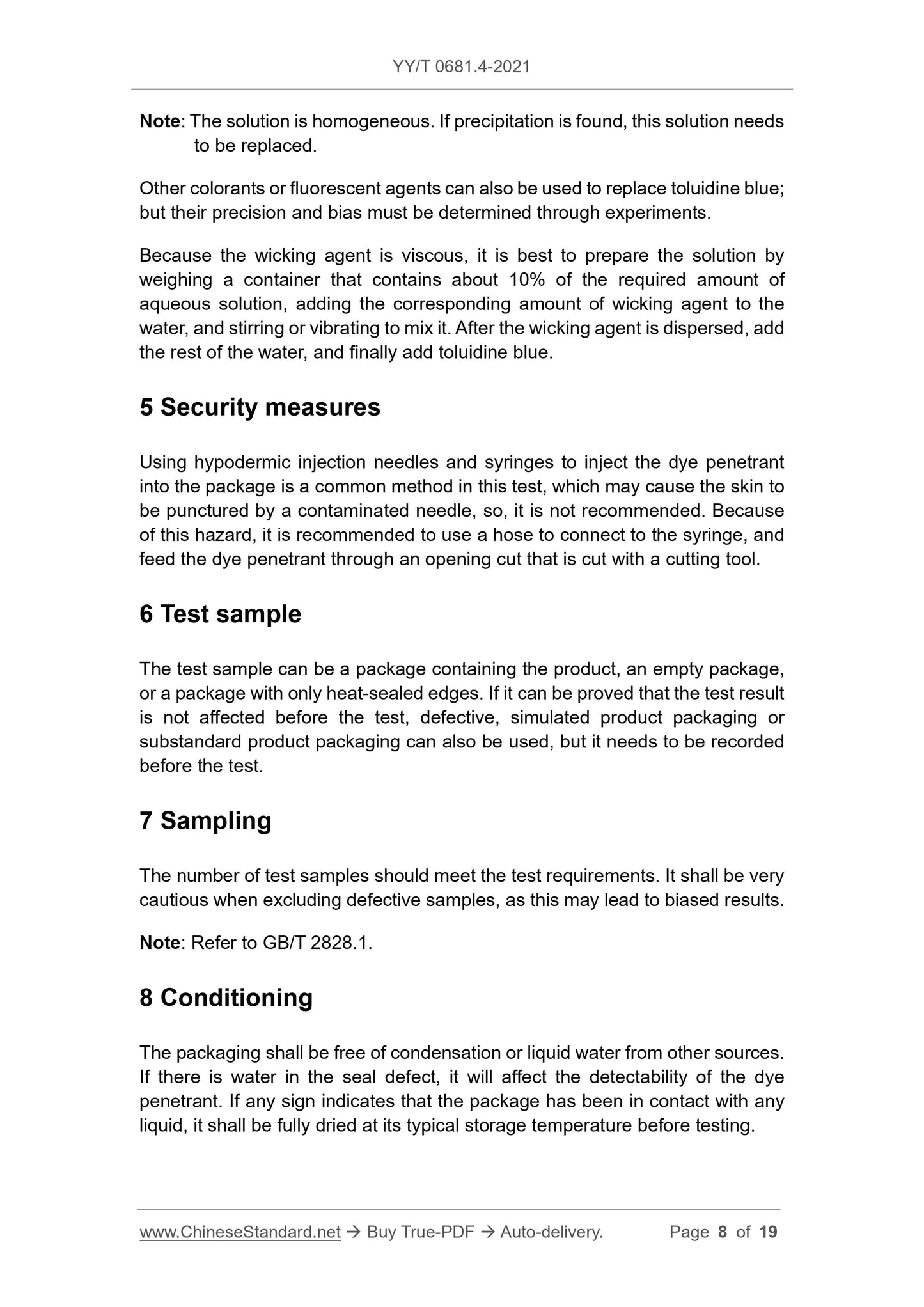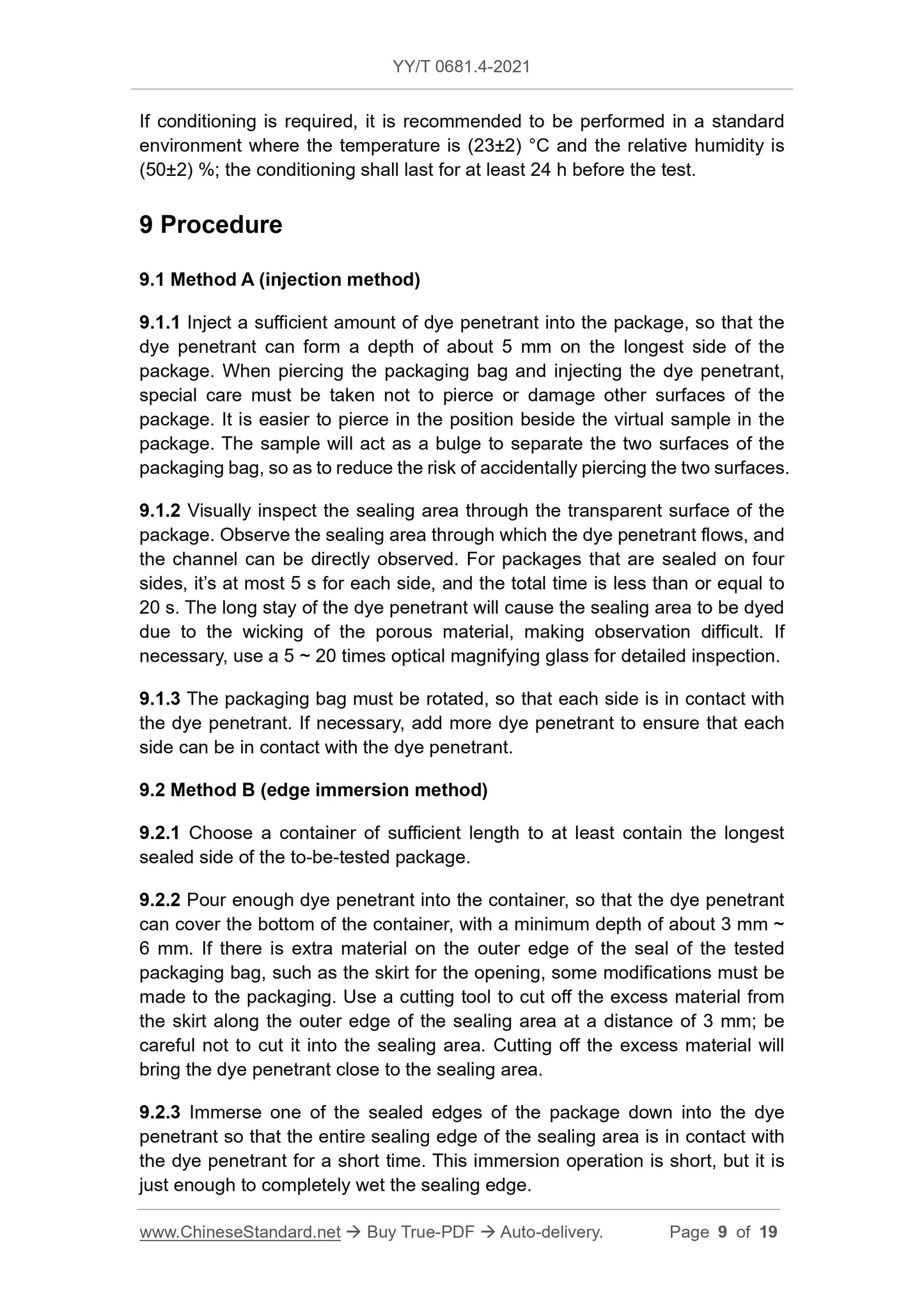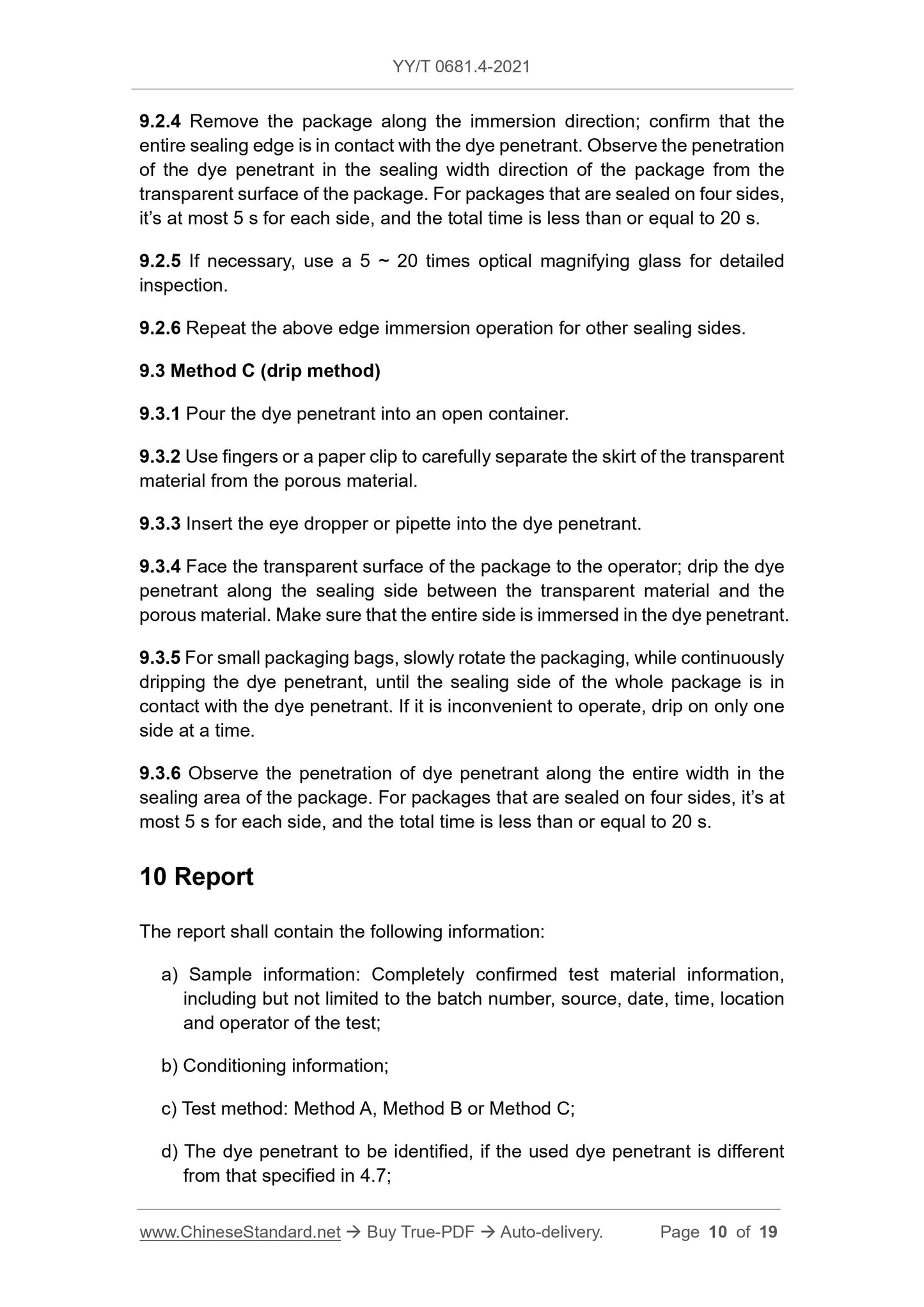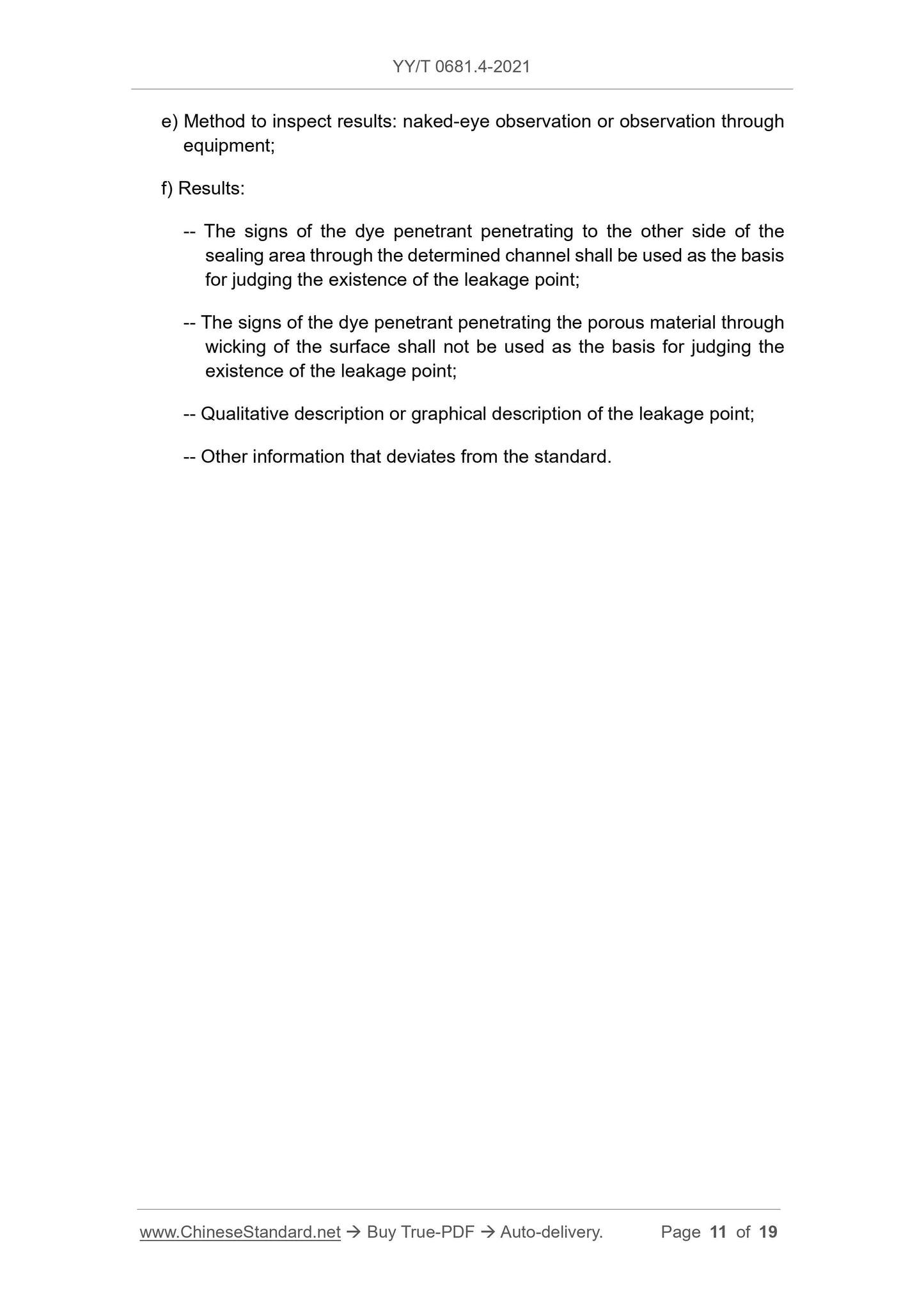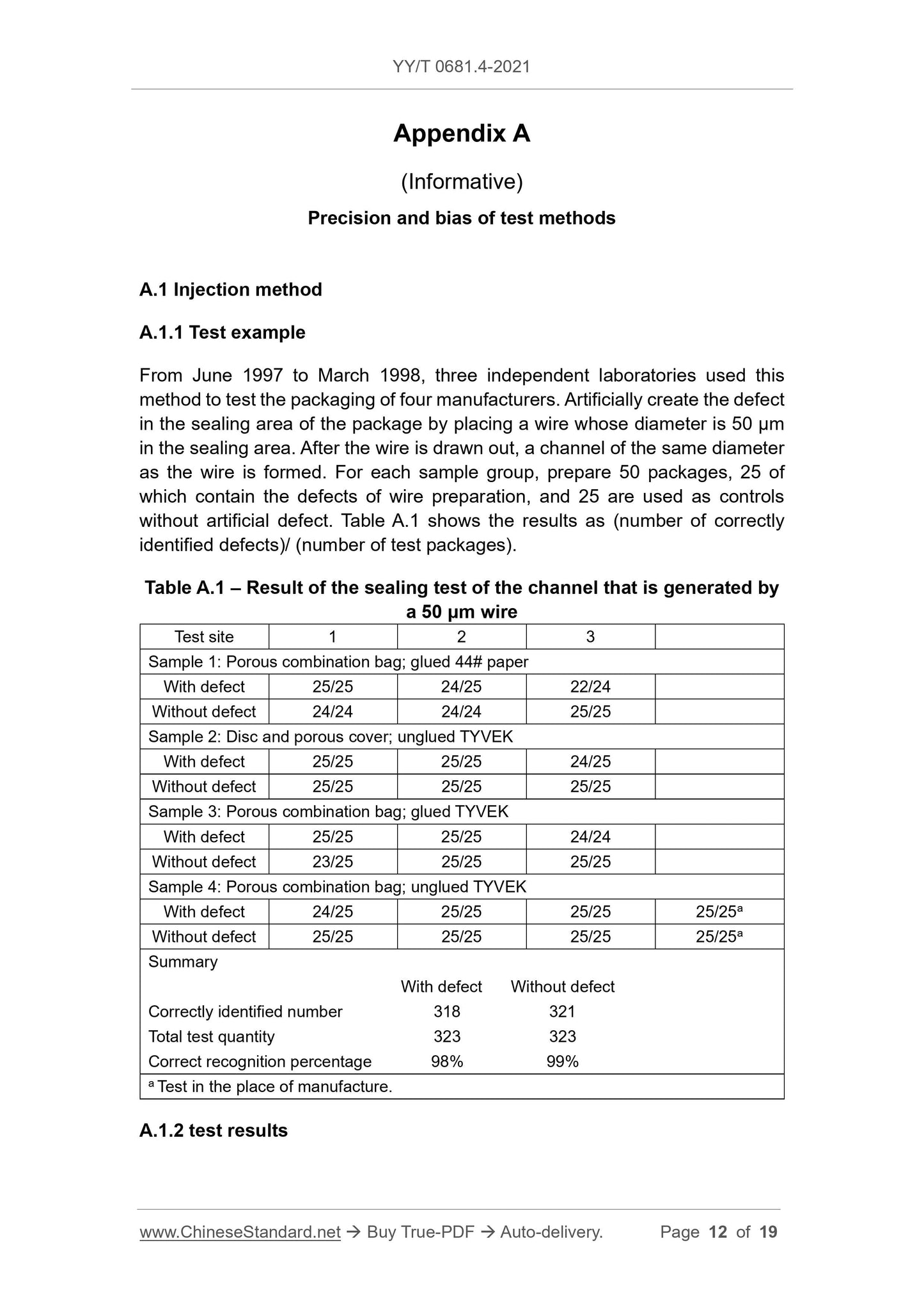1
/
de
12
PayPal, credit cards. Download editable-PDF & invoice in 1 second!
YY/T 0681.4-2021 English PDF (YYT0681.4-2021)
YY/T 0681.4-2021 English PDF (YYT0681.4-2021)
Prix habituel
$215.00 USD
Prix habituel
Prix promotionnel
$215.00 USD
Prix unitaire
/
par
Frais d'expédition calculés à l'étape de paiement.
Impossible de charger la disponibilité du service de retrait
Delivery: 3 seconds. Download true-PDF + Invoice.
Get QUOTATION in 1-minute: Click YY/T 0681.4-2021
Historical versions: YY/T 0681.4-2021
Preview True-PDF (Reload/Scroll if blank)
YY/T 0681.4-2021: Test methods for sterile medical device package -- Part 4: Detecting seal leaks in porous packages by dye penetration
YY/T 0681.4-2021
YY
PHARMACEUTICAL INDUSTRY STANDARD
OF THE PEOPLE’S REPUBLIC OF CHINA
ICS 11.080.40
C 31
Replacing YY/T 0681.4-2010
Test methods for sterile medical device package - Part
4: Detecting seal leaks in porous packages by dye
penetration
ISSUED ON: MARCH 09, 2021
IMPLEMENTED ON: APRIL 01, 2022
Issued by: National Medical Products Administration
Table of Contents
Foreword ... 3
Introduction ... 5
1 Scope ... 6
2 Terms and definitions ... 6
3 Significance and application ... 7
4 Instruments ... 7
5 Security measures ... 8
6 Test sample ... 8
7 Sampling ... 8
8 Conditioning ... 8
9 Procedure ... 9
10 Report ... 10
Appendix A (Informative) Precision and bias of test methods ... 12
Appendix B (Informative) False positive guidelines ... 17
References ... 19
Test methods for sterile medical device package - Part
4: Detecting seal leaks in porous packages by dye
penetration
1 Scope
This Part of YY/T 0681 specifies the test method for detecting seal leaks in
porous packages by dye penetrant.
This Part applies to the detection of channel, whose package sealing area is
greater than or equal to 50 μm, that is composed of transparent materials and
porous materials.
This Part does not apply to porous materials that are dyed due to wicking within
5 s; it does not apply to situations where the dye penetrant is not much different
from opaque materials.
2 Terms and definitions
The following terms and definitions are applicable to this document.
2.1
Wicking
The liquid moves into the fibrous material.
2.2
Dye penetrant
A mixed aqueous solution of a coloring agent and a surfactant, which is
designed to indicate the location of the defect in the period before wicking
(which masks the existence of the defect).
2.3
Channel
Any undamaged path across the entire width of the intended sealing area.
If conditioning is required, it is recommended to be performed in a standard
environment where the temperature is (23±2) °C and the relative humidity is
(50±2) %; the conditioning shall last for at least 24 h before the test.
9 Procedure
9.1 Method A (injection method)
9.1.1 Inject a sufficient amount of dye penetrant into the package, so that the
dye penetrant can form a depth of about 5 mm on the longest side of the
package. When piercing the packaging bag and injecting the dye penetrant,
special care must be taken not to pierce or damage other surfaces of the
package. It is easier to pierce in the position beside the virtual sample in the
package. The sample will act as a bulge to separate the two surfaces of the
packaging bag, so as to reduce the risk of accidentally piercing the two surfaces.
9.1.2 Visually inspect the sealing area through the transparent surface of the
package. Observe the sealing area through which the dye penetrant flows, and
the channel can be directly observed. For packages that are sealed on four
sides, it’s at most 5 s for each side, and the total time is less than or equal to
20 s. The long stay of the dye penetrant will cause the sealing area to be dyed
due to the wicking of the porous material, making observation difficult. If
necessary, use a 5 ~ 20 times optical magnifying glass for detailed inspection.
9.1.3 The packaging bag must be rotated, so that each side is in contact with
the dye penetrant. If necessary, add more dye penetrant to ensure that each
side can be in contact with the dye penetrant.
9.2 Method B (edge immersion method)
9.2.1 Choose a container of sufficient length to at least contain the longest
sealed side of the to-be-tested package.
9.2.2 Pour enough dye penetrant into the container, so that the dye penetrant
can cover the bottom of the container, with a minimum depth of about 3 mm ~
6 mm. If there is extra material on the outer edge of the seal of the tested
packaging bag, such as the skirt for the opening, some modifications must be
made to the packaging. Use a cutting tool to cut off the excess material from
the skirt along the outer edge of the sealing area at a distance of 3 mm; be
careful not to cut it into the sealing area. Cutting off the excess material will
bring the dye penetrant close to the sealing area.
9.2.3 Immerse one of the sealed edges of the package down into the dye
penetrant so that the entire sealing edge of the sealing area is in contact with
the dye penetrant for a short time. This immersion operation is short, but it is
just enough to completely wet the sealing edge.
9.2.4 Remove the package along the immersion direction; confirm that the
entire sealing edge is in contact with the dye penetrant. Observe the penetration
of the dye penetrant in the sealing width direction of the package from the
transparent surface of the package. For packages that are sealed on four sides,
it’s at most 5 s for each side, and the total time is less than or equal to 20 s.
9.2.5 If necessary, use a 5 ~ 20 times optical magnifying glass for detailed
inspection.
9.2.6 Repeat the above edge immersion operation for other sealing sides.
9.3 Method C (drip method)
9.3.1 Pour the dye penetrant into an open container.
9.3.2 Use fingers or a paper clip to carefully separate the skirt of the transparent
material from the porous material.
9.3.3 Insert the eye dropper or pipette into the dye penetrant.
9.3.4 Face the transparent surface of the package to the operator; drip the dye
penetrant along the sealing side between the transparent material and the
porous material. Make sure that the entire side is immersed in the dye penetrant.
9.3.5 For small packaging bags, slowly rotate the packaging, while continuously
dripping the dye penetrant, until the sealing side of the whole package is in
contact with the dye penetrant. If it is inconvenient to operate, drip on only one
side at a time.
9.3.6 Observe the penetration of dye penetrant along the entire width in the
sealing area of the package. For packages that are sealed on four sides, it’s at
most 5 s for each side, and the total time is less than or equal to 20 s.
10 Report
The report shall contain the following information:
a) Sample information: Completely confirmed test material information,
including but not limited to the batch number, source, date, time, location
and operator of the test;
b) Conditioning information;
c) Test method: Method A, Method B or Method C;
d) The dye penetrant to be identified, if the used dye penetrant is different
from that specified in 4.7;
The test results show that, when using the coloring agent that is specified in
this method to test the package, one side of which is a porous material, the
measurement confidence of the channel that is constructed of a wire whose
diameter is 50 μm is more than 95%. It was observed in this test series that
when using indicator dye liquid other than toluidine blue to test the bag that is
composed of plastic film, the test performance is significantly reduced (the
probability of detection of a defect is < 60%). Early-developed tests show that
when other wicking reagents are used, the inspection capacity is obviously poor;
based on these test results, the formulations of the coloring agents and wicking
agents in this test method are specified.
A.2 Edge immersion method and drip method
A.2.1 Test example
Laboratory studies on the edge immersion method and drip method in the
standard were carried out in 2012. 12 laboratories par...
Get QUOTATION in 1-minute: Click YY/T 0681.4-2021
Historical versions: YY/T 0681.4-2021
Preview True-PDF (Reload/Scroll if blank)
YY/T 0681.4-2021: Test methods for sterile medical device package -- Part 4: Detecting seal leaks in porous packages by dye penetration
YY/T 0681.4-2021
YY
PHARMACEUTICAL INDUSTRY STANDARD
OF THE PEOPLE’S REPUBLIC OF CHINA
ICS 11.080.40
C 31
Replacing YY/T 0681.4-2010
Test methods for sterile medical device package - Part
4: Detecting seal leaks in porous packages by dye
penetration
ISSUED ON: MARCH 09, 2021
IMPLEMENTED ON: APRIL 01, 2022
Issued by: National Medical Products Administration
Table of Contents
Foreword ... 3
Introduction ... 5
1 Scope ... 6
2 Terms and definitions ... 6
3 Significance and application ... 7
4 Instruments ... 7
5 Security measures ... 8
6 Test sample ... 8
7 Sampling ... 8
8 Conditioning ... 8
9 Procedure ... 9
10 Report ... 10
Appendix A (Informative) Precision and bias of test methods ... 12
Appendix B (Informative) False positive guidelines ... 17
References ... 19
Test methods for sterile medical device package - Part
4: Detecting seal leaks in porous packages by dye
penetration
1 Scope
This Part of YY/T 0681 specifies the test method for detecting seal leaks in
porous packages by dye penetrant.
This Part applies to the detection of channel, whose package sealing area is
greater than or equal to 50 μm, that is composed of transparent materials and
porous materials.
This Part does not apply to porous materials that are dyed due to wicking within
5 s; it does not apply to situations where the dye penetrant is not much different
from opaque materials.
2 Terms and definitions
The following terms and definitions are applicable to this document.
2.1
Wicking
The liquid moves into the fibrous material.
2.2
Dye penetrant
A mixed aqueous solution of a coloring agent and a surfactant, which is
designed to indicate the location of the defect in the period before wicking
(which masks the existence of the defect).
2.3
Channel
Any undamaged path across the entire width of the intended sealing area.
If conditioning is required, it is recommended to be performed in a standard
environment where the temperature is (23±2) °C and the relative humidity is
(50±2) %; the conditioning shall last for at least 24 h before the test.
9 Procedure
9.1 Method A (injection method)
9.1.1 Inject a sufficient amount of dye penetrant into the package, so that the
dye penetrant can form a depth of about 5 mm on the longest side of the
package. When piercing the packaging bag and injecting the dye penetrant,
special care must be taken not to pierce or damage other surfaces of the
package. It is easier to pierce in the position beside the virtual sample in the
package. The sample will act as a bulge to separate the two surfaces of the
packaging bag, so as to reduce the risk of accidentally piercing the two surfaces.
9.1.2 Visually inspect the sealing area through the transparent surface of the
package. Observe the sealing area through which the dye penetrant flows, and
the channel can be directly observed. For packages that are sealed on four
sides, it’s at most 5 s for each side, and the total time is less than or equal to
20 s. The long stay of the dye penetrant will cause the sealing area to be dyed
due to the wicking of the porous material, making observation difficult. If
necessary, use a 5 ~ 20 times optical magnifying glass for detailed inspection.
9.1.3 The packaging bag must be rotated, so that each side is in contact with
the dye penetrant. If necessary, add more dye penetrant to ensure that each
side can be in contact with the dye penetrant.
9.2 Method B (edge immersion method)
9.2.1 Choose a container of sufficient length to at least contain the longest
sealed side of the to-be-tested package.
9.2.2 Pour enough dye penetrant into the container, so that the dye penetrant
can cover the bottom of the container, with a minimum depth of about 3 mm ~
6 mm. If there is extra material on the outer edge of the seal of the tested
packaging bag, such as the skirt for the opening, some modifications must be
made to the packaging. Use a cutting tool to cut off the excess material from
the skirt along the outer edge of the sealing area at a distance of 3 mm; be
careful not to cut it into the sealing area. Cutting off the excess material will
bring the dye penetrant close to the sealing area.
9.2.3 Immerse one of the sealed edges of the package down into the dye
penetrant so that the entire sealing edge of the sealing area is in contact with
the dye penetrant for a short time. This immersion operation is short, but it is
just enough to completely wet the sealing edge.
9.2.4 Remove the package along the immersion direction; confirm that the
entire sealing edge is in contact with the dye penetrant. Observe the penetration
of the dye penetrant in the sealing width direction of the package from the
transparent surface of the package. For packages that are sealed on four sides,
it’s at most 5 s for each side, and the total time is less than or equal to 20 s.
9.2.5 If necessary, use a 5 ~ 20 times optical magnifying glass for detailed
inspection.
9.2.6 Repeat the above edge immersion operation for other sealing sides.
9.3 Method C (drip method)
9.3.1 Pour the dye penetrant into an open container.
9.3.2 Use fingers or a paper clip to carefully separate the skirt of the transparent
material from the porous material.
9.3.3 Insert the eye dropper or pipette into the dye penetrant.
9.3.4 Face the transparent surface of the package to the operator; drip the dye
penetrant along the sealing side between the transparent material and the
porous material. Make sure that the entire side is immersed in the dye penetrant.
9.3.5 For small packaging bags, slowly rotate the packaging, while continuously
dripping the dye penetrant, until the sealing side of the whole package is in
contact with the dye penetrant. If it is inconvenient to operate, drip on only one
side at a time.
9.3.6 Observe the penetration of dye penetrant along the entire width in the
sealing area of the package. For packages that are sealed on four sides, it’s at
most 5 s for each side, and the total time is less than or equal to 20 s.
10 Report
The report shall contain the following information:
a) Sample information: Completely confirmed test material information,
including but not limited to the batch number, source, date, time, location
and operator of the test;
b) Conditioning information;
c) Test method: Method A, Method B or Method C;
d) The dye penetrant to be identified, if the used dye penetrant is different
from that specified in 4.7;
The test results show that, when using the coloring agent that is specified in
this method to test the package, one side of which is a porous material, the
measurement confidence of the channel that is constructed of a wire whose
diameter is 50 μm is more than 95%. It was observed in this test series that
when using indicator dye liquid other than toluidine blue to test the bag that is
composed of plastic film, the test performance is significantly reduced (the
probability of detection of a defect is < 60%). Early-developed tests show that
when other wicking reagents are used, the inspection capacity is obviously poor;
based on these test results, the formulations of the coloring agents and wicking
agents in this test method are specified.
A.2 Edge immersion method and drip method
A.2.1 Test example
Laboratory studies on the edge immersion method and drip method in the
standard were carried out in 2012. 12 laboratories par...
Share
